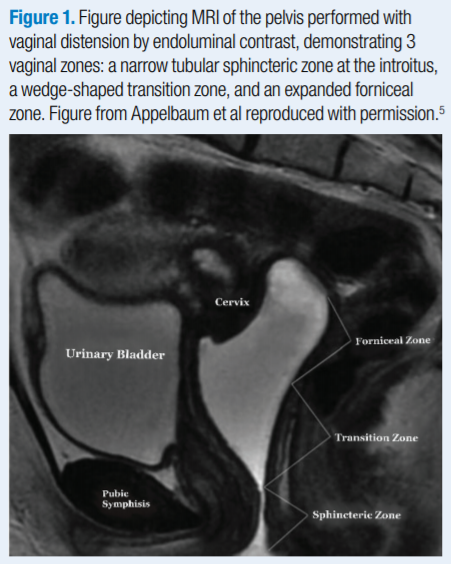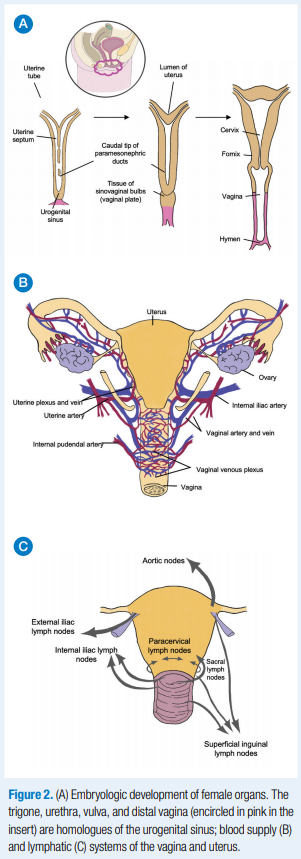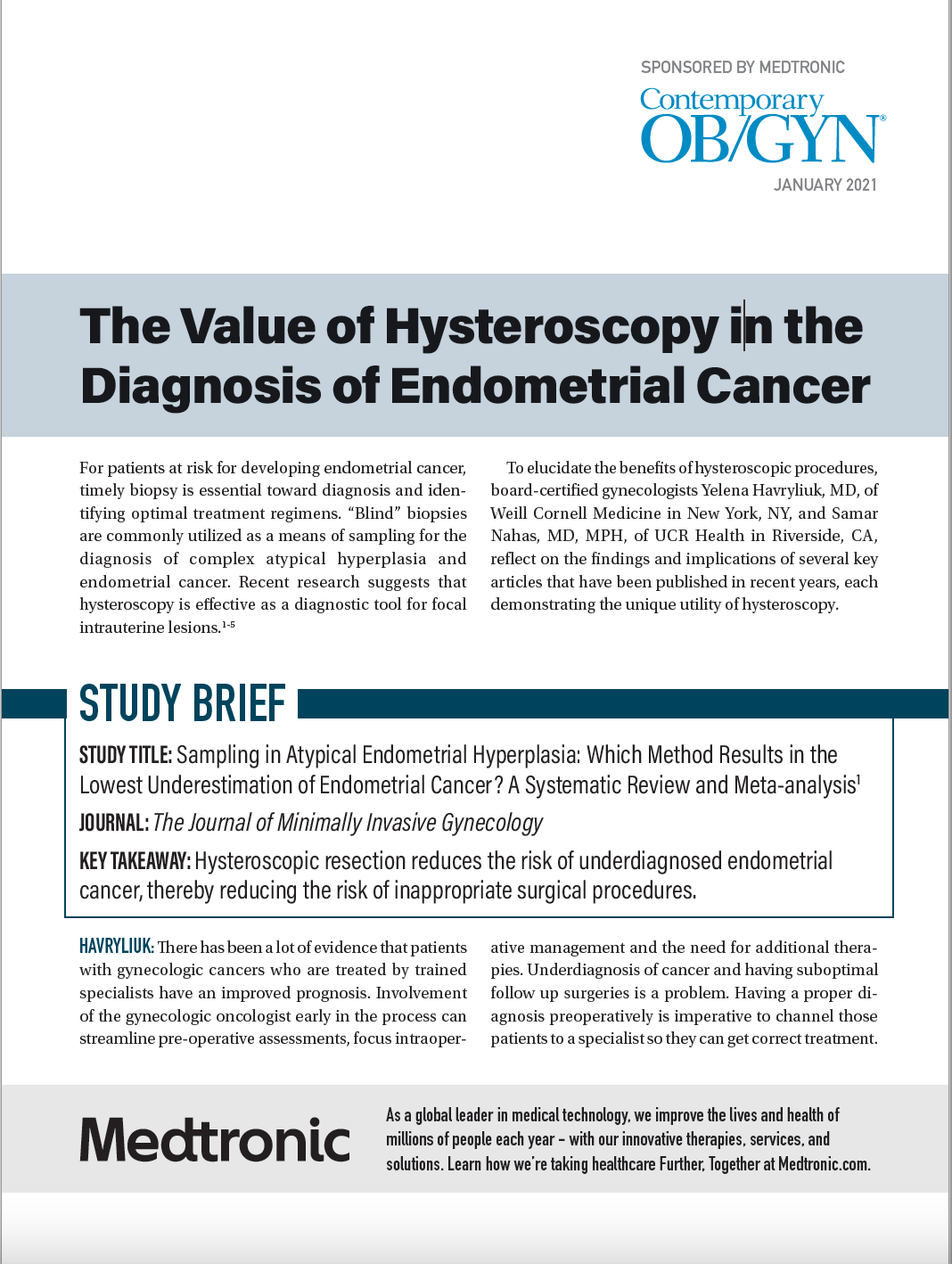Celebrating the Vagina: The Vagina as Effective Route of Drug Delivery
Sponsored Content

Sponsored by: TherapeuticsMD, Inc.
Although more than half of the adults in the US are women,1 use of the word vagina by the media or in politics has always been somewhat taboo, creating mystery around the vagina for much of the general population. However, in the medical field the vagina is a well-known route of drug administration, effectively bypassing liver metabolism and allowing both local and systemic drug delivery.
Anatomy and Physiology
The vagina is an elastic, muscular canal with a soft, flexible lining covered by an epithelium, connecting the uterus to the outside world. In women of reproductive age, the vagina has numerous folds called rugae, which provide distensibility and support and increase the surface area of the vaginal wall (total surface area is approximately 90 cm).2 As a collapsed organ, it measures 8 to 12 cm in length, beginning with the vulva and labia and ending at the cervix. Although the vagina is often depicted as a straight tube,3-5 it is really a curved (130°) organ with 3 distinct portions (Figure 15 ): a lower sphincteric zone (entrance), a transition zone (convex portion), and a wider forniceal zone (upper portion). The anatomy of the vagina lends itself to drug delivery, since the upper portion lies almost horizontally when a woman is standing, meaning, for example, that inserted vaginal products, such as a contraceptive ring, should not be dislodged.
The pH of the vagina is normally acidic (≤ 4.5) and is thought to be related to the abundance of Lactobacilli species and high levels of glycogen in the vaginal tract.6,7 During menopause, the vaginal epithelium becomes thinner by a reduction of its superficial cells, and the mucosa becomes pale due to a lack of underlying vasculature, caused by declining estrogen levels, ultimately leading to vulvar and vaginal atrophy.7 This thinning of the vaginal epithelium also results in decreased production and secretion of glycogen, which is thought to contribute to the more basic vaginal pH (> 5) observed in postmenopausal women.7,8
The vagina functions as a birth canal, a passage for menstrual blood, and a repository for sperm during sex. A woman’s age, hormone status, and pregnancy status can influence the vagina’s physiology. Estrogen status, menstruation, semen, and bacterial colonization can alter its pH.3
Microbiomes Can Be Diverse
The vaginal microbiome plays an important role in preventing the colonization of the vagina by pathogenic


organisms,6 including urinary tract and sexually transmitted infectious agents. The composition of the microbiome can be diverse across women in terms of type and abundance. It is mainly composed of Lactobacillus species, which helps protect the vagina from pathogens by producing lactic acid.9 Women of reproductive age can be categorized into 5 groups, depending on the dominant organisms, and over time the profile of the vaginal microbiome changes with postmenopausal women having the least amount of Lactobacillus species.10,11 A reduction in Lactobacillus levels could be a contributor to a less acidic vaginal pH in postmenopausal women, but the decrease in Lactobacillus levels may also be due to decreases in glycogen levels caused by decreased vaginal epithelium.7
Bacterial vaginosis (BV) is a common type of vaginal inflammation caused by bacterial overgrowth that results in a disruption of the microbiome’s normal equilibrium. BV has been shown to make women more susceptible to sexually transmitted diseases, including HIV.12,13 Bacterial vaginosis also may play a role in preterm deliveries.14
Nerve Supply
The majority of the vagina’s innervation comes from the autonomic nervous system,3 which has sympathetic and parasympathetic fibers that supply the vagina through the uterovaginal plexus. Because there is no sensory innervation in the upper vagina and autonomic fibers respond to stretch but are not very sensitive to pain or temperature, the upper vagina is a relatively insensitive area. For this reason, women rarely feel any discomfort from vaginal products such as vaginal contraceptive rings, tampons, or suppositories inserted in the vagina. Only the bottom quarter of the vagina receives sensory or somatic innervation via peripheral nerves.
Embryologic Development Predicts Patterns
The vagina is composed of 2 distinct sets of embryologically derived tissues. The upper half of the vagina, the uterus, and the cervix are derived from the Müllerian ducts (paramesonephric ducts), whereas the lower portion of the vagina, the urethra, the vulva and the introitus are derived from the urogenital sinus (Figure 2A).15 Structures derived from the urogenital sinus have some of the highest concentrations of estrogen receptors in the female body,16,17 unlike the upper portion of the vagina.18
These embryological differences may also help explain the distinct irrigation and drainage of the upper and lower parts of the vagina. Arterial blood supply and venous drainage of the upper vagina occur through the branches of the internal iliac artery and veins as well as the uterine and vaginal artery and veins, whereas for the lower vagina, they occur through the internal pudendal artery and vaginal venous plexus (Figure 2B). Lymphatic drainage in the vagina is also regional and depends on embryology: the upper vagina drains into the external iliac nodes, the middle vagina into the internal iliac nodes, and the lower vagina into the superficial inguinal nodes and perineum (Figure 2C).
These regional characteristics were first observed in an early study of vaginal progesterone, which showed that progesterone delivered in the upper part of the vagina had preferential effects on the uterus and endometrium.19 Similarly, differential lymphatic drainage was observed in studies of vaginal cancer showing that tumors arising in the upper two-thirds of the vagina metastasize to the pelvic lymph nodes, whereas tumors in the lower third of the vagina metastasize to the inguinal and femoral nodes.20 Since the vascular and lymphatic circulatory patterns in the vagina follow these embryonic developmental templates, medications administered into the upper vagina are likely to be distributed preferentially into the pelvic organs.
Studying the Uterine First-Pass Effect
The concept of the uterine first-pass effect was initially proposed by Bulletti et al,21,22 who postulated that steroid compounds placed in the upper vagina would be preferentially delivered to the uterus with subsequent passage into the systemic circulation. They performed in vitro studies on uteri/upper vaginal preparations perfused with culture medium.22 Radiolabeled progesterone placed in the upper vagina was rapidly absorbed into the uterine circulation with longer-lasting accumulation in the endometrium and myometrium.22 These studies demonstrated the delivery of steroids to the systemic circulation and regionally to the myometrium and endometrium when placed in the upper vagina.22 Accordingly, rapid systemic circulation of drugs is observed in women who use contraceptive or menopausal vaginal rings, which are placed in the upper part of the vagina.23-25
Drug Delivery Affects the Periurethral Area
The concept that in vivo drug delivery from the vagina would differ depending on where medications are positioned within the vagina was tested in a randomized trial of an estradiol (E2) tablet vaginal insert placed in the lower (outer) third of the vagina versus the upper (inner) third in postmenopausal women aged 54 to 61 years.26 In these studies, placing the E2 tablet in the lower vagina significantly increased periurethral blood flow (129%) but not uterine artery flow, whereas placing the E2 tablet in the upper vagina significantly increased both ipsilateral and contralateral uterine artery blood flow (≥ 198%) and significantly decreased blood flow in the urethrovaginal septum.26 These results are consistent with data showing that E2 rapidly stimulates arterial dilation.27 Differential effects by vaginal site of administration were also demonstrated26 and confirmed28 by Doppler examination of the pulsatility index (PI) and resistance index (RI). Drug delivery to the lower vagina did not change PI or RI at any site,26,28 whereas administration to the upper third of the vagina reduced PI and RI in both uterine arteries26,28 but not in the urethrovaginal septum. 26 Furthermore, in a study of healthy postmenopausal women,29 E2 levels with an E2 softgel vaginal insert (placed in the lower vaginal canal [1 to 2 inches]30) remained within the postmenopausal range and were lower than with a vaginal tablet comparator (inserted with its applicator in the upper part of the vagina31). In fact, the E2 areas under the time-concentration curve0-24 for the 10-μg and 25-μg doses were 3 times lower with the E2 vaginal insert than with the same doses of the E2 vaginal tablet.29
Advantages of Vaginal Drug Administration
Vaginal drug delivery has been used for more than 60 years, since the documentation of effective penicillin absorption with vaginal suppositories.32 Vaginal administration of a drug has been noted as easy, painless for the patient, requiring no intervention by medical personnel, discreet/private, reversible, having minimal interference with body function and daily life, having high bioavailability with little variability, and having minimal interference with other medications.3
The vaginal route of administration can also provide both systemic and local drug delivery and effects.33 The rich complex network of capillaries of the upper vagina makes it a good systemic drug delivery system as it eliminates intestinal-hepatic first-pass metabolism.33,34 Contraceptive rings positioned higher in the vagina, at the level of the entrance to the uterus, would provide systemic exposure35,36 and may allow for steadier hormone levels than the peaks

and troughs that result with a daily pill.23,24 Such steady-state hormone levels would reduce the chance of breakthrough bleeding.
Conversely, application of a low-dose vaginal softgel insert in the lower part of the vagina can locally treat vulvar and vaginal atrophy with minimal systemic absorption.30 Estradiol absorption is dose dependent and may be influenced by dose, formulation, and positioning in the vagina.37 However, larger than prescribed amounts of estrogen creams, particularly those placed higher into the vagina with an applicator, may result in unnecessary systemic absorption. With vaginal progesterone for luteal phase support, the uterine first-pass effect allows hormones to concentrate in the uterus and nearby tissues with low systemic exposure.33,38
Newer technologies may also enhance use of the vagina for drug delivery. For example, different vaginal mucoadhesive polymers are prominent and continue to be developed.39 Other options explored for vaginal drug delivery include vaginal vaccines and microbicides.39
Conclusion
Although the vagina is rarely talked about openly, it warrants attention and more open discussion. It is essential for birth, menstruation, and reproduction, and it can serve as a great route for drug administration. Drug delivery via the vagina allows for local or systemic effects depending, in part, on where the drug is positioned within the vagina and the formulation of the drug product. Although this specific route of administration can only be used in women, elimination of intestinal-hepatic first-pass metabolism makes it a very interesting organ for drug delivery
REFERENCES
1. U.S. Census Bureau. Age and sex survey/program. 2019. Accessed April 8, 2021. https://data.census.gov/cedsci/table?q=sex%20and%20age&tid=ACSST1Y2019. S0101&hidePreview=false
2. Pendergrass PB, Belovicz MW, Reeves CA. Surface area of the human vagina as measured from vinyl polysiloxane casts. Gynecol Obstet Invest. 2003;55(2):110-113. doi:10.1159/000070184
3. Alexander NJ, Baker E, Kaptein M, Karck U, Miller L, Zampaglione E. Why consider vaginal drug administration? Fertil Steril. 2004;82(1):1-12. doi:10.1016/j.fertnstert.2004.01.025
4. Funt MI, Thompson JD, Birch H. Normal vaginal axis. South Med J. 1978;71(12):1534-1535, 1552. doi:10.1097/00007611-197812000-00026
5. Appelbaum AH, Zuber JK, Levi-D’Ancona R, Cohen HL. Vaginal anatomy on MRI: New information obtained using distention. South Med J. 2018;111(11):691-697. doi:10.14423/ SMJ.0000000000000889
6. Miller EA, Beasley DE, Dunn RR, Archie EA. Lactobacilli dominance and vaginal pH: why is the human vaginal microbiome unique? Front Microbiol. 2016;7:1936. doi:10.3389/ fmicb.2016.01936
7. Tucker KM, Godha K, Mirkin S, Archer DF. Vaginal pH: a simple assessment highly correlated with vaginal morphology and symptoms in postmenopausal women. Menopause. 2018;25(7):762- 766. doi:10.1097/GME.0000000000001081
8. Roy S, Caillouette JC, Roy T, Faden JS. Vaginal pH is similar to follicle-stimulating hormone for menopause diagnosis. Am J Obstet Gynecol. 2004;190(5):1272-1277. doi:10.1016/j. ajog.2003.12.015
9. Brooks JP, Edwards DJ, Blithe DL, et al. Effects of combined oral contraceptives, depot medroxyprogesterone acetate and the levonorgestrel-releasing intrauterine system on the vaginal microbiome. Contraception. 2017;95(4):405-413. doi:10.1016/j. contraception.2016.11.006
10. Ravel J, Gajer P, Abdo Z, et al. Vaginal microbiome of reproductive-age women. Proc Natl Acad Sci USA. 2011;108(suppl 1):4680-4687. doi:10.1073/pnas.1002611107
11. Brotman RM, Shardell MD, Gajer P, et al. Association between the vaginal microbiota, menopause status, and signs of vulvovaginal atrophy. Menopause. 2014;21(5):450-458. doi:10.1097/GME.0000000000001236
12. Atashili J, Poole C, Ndumbe PM, Adimora AA, Smith JS. Bacterial vaginosis and HIV acquisition: a meta-analysis of published studies. AIDS. 2008;22(12):1493-1501. doi:10.1097/ QAD.0b013e3283021a37
13. Ness RB, Kip KE, Soper DE, et al. Bacterial vaginosis (BV) and the risk of incident gonococcal or chlamydial genital infection in a predominantly black population. Sex Transm Dis. 2005;32(7):413-417. doi:10.1097/01.olq.0000154493.87451.8d
14. Shimaoka M, Yo Y, Doh K, et al. Association between preterm delivery and bacterial vaginosis with or without treatment. Sci Rep. 2019;9(1):509. doi:10.1038/s41598-018-36964-2
15. Robboy SJ, Kurita T, Baskin L, Cunha GR. New insights into human female reproductive tract development. Differentiation. 2017;97:9-22. doi:10.1016/j.diff.2017.08.002
16. Iosif CS, Batra S, Ek A, Astedt B. Estrogen receptors in the human female lower uninary tract. Am J Obstet Gynecol. 1981;141(7):817-820. doi:10.1016/0002-9378(81)90710-9
17. Forsberg JG. A morphologist’s approach to the vagina—age-related changes and estrogen sensitivity. Maturitas. 1995;22(suppl:S7-S15). doi:10.1016/0378-5122(95)00957-4
18. Freedman MA. Vaginal pH, estrogen and genital atrophy. Menopause Management. September 7, 2007. https://www.menopausemgmt.com/vaginal-ph-estrogen-and-genital-atrophy/
19. Miles RA, Paulson RJ, Lobo RA, Press MF, Dahmoush L, Sauer MV. Pharmacokinetics and endometrial tissue levels of progesterone after administration by intramuscular and vaginal routes: a comparative study. Fertil Steril. 1994;62(3):485-490. doi:10.1016/s0015- 0282(16)56935-0
20. Paño B, Sebastia C, Ripoll E, et al. Pathways of lymphatic spread in gynecologic malignancies. Radiographics. 2015;35(3):916-945. doi:10.1148/rg.2015140086
21. Bulletti C, de Ziegler D, Flamigni C, et al. Targeted drug delivery in gynaecology: the first uterine pass effect. Hum Reprod. 1997;12(5):1073-1079. doi:10.1093/humrep/12.5.1073
22. Bulletti C, De Ziegler D, Giacomucci E, et al. Vaginal drug delivery: the first uterine pass effect. Ann N Y Acad Sci. 1997;828:285-290. doi:10.1111/j.1749-6632.1997.tb48549.x
23. Timmer CJ, Mulders TM. Pharmacokinetics of etonogestrel and ethinylestradiol released from a combined contraceptive vaginal ring. Clin Pharmacokinet. 2000;39(3):233-242. doi:10.2165/00003088-200039030-00005
24. Liu JH, Plagianos M, Archer DF, et al. Segesterone acetate serum levels with a regression model of continuous use of the segesterone acetate/ethinyl estradiol contraceptive vaginal system. Contraception. Published online March 27, 2021. doi:10.1016/j.contraception.2021.03.024
25. Femring (estradiol acetate vaginal ring). Prescribing information. Warner Chilcott UK Limited; 2005. Accessed July 8, 2021. https://www.femring.com/downloads/New-Femring-USPI-andPPI-Sept-2018.pdf
26. Cicinelli E, Di Naro E, De Ziegler D, et al. Placement of the vaginal 17beta-estradiol tablets in the inner or outer one third of the vagina affects the preferential delivery of 17beta-estradiol toward the uterus or periurethral areas, thereby modifying efficacy and endometrial safety. Am J Obstet Gynecol. 2003;189(1):55-58. doi:10.1067/mob.2003.341
27. Guo X, Razandi M, Pedram A, Kassab G, Levin ER. Estrogen induces vascular wall dilation: mediation through kinase signaling to nitric oxide and estrogen receptors alpha and beta. J Biol Chem. 2005;280(20):19704-19710. doi:10.1074/jbc.M501244200
28. Cicinelli E, De Ziegler D, Morgese S, Bulletti C, Luisi D, Schonauer LM. “First uterine pass effect” is observed when estradiol is placed in the upper but not lower third of the vagina. Fertil Steril. 2004;81(5):1414-1416. doi:10.1016/j.fertnstert.2003.12.016
29. Pickar JH, Amadio JM, Bernick BA, Mirkin S. Pharmacokinetic studies of solubilized estradiol given vaginally in a novel softgel capsule. Climacteric. 2016;19(2):181-187. doi:10.3109/136 97137.2015.1136926
30. Imvexxy. Prescribing information. TherapeuticsMD; 2018. Accessed July 8, 2021. https://www. imvexxy.com/pi.pdf
31. Vagifem. Prescribing information. Novo Nordisk; 2017. Accessed July 8, 2021. https://www. novo-pi.com/vagifem.pdf
32. Rock J, Barker RH, Bacon WB. Vaginal absorption of penicillin. Science. 1947;105(2714):13. doi:10.1126/science.105.2714.13
33. Cicinelli E. Intravaginal oestrogen and progestin administration: advantages and disadvantages. Best Pract Res Clin Obstet Gynaecol. 2008;22(2):391-405. doi:10.1016/j. bpobgyn.2007.08.010
34. Liu JH, Bernick B, Mirkin S. Estradiol softgel inserts for the treatment of VVA symptoms: an expert opinion. Expert Opin Drug Deliv. 2020;17(11):1573-1581. doi:10.1080/17425247.20 20.1810662
35. Annovera. Prescribing information. TherapeuticsMD; 2018. Accessed July 8, 2021. https:// www.annovera.com/pi.pdf
36. NuvaRing. Prescribing information. Merck; 2020. Accessed July 8, 2021. https://www.nuvaring. com/static/pdf/nuvaring-pi.pdf
37. Santen RJ, Mirkin S, Bernick B, Constantine GD. Systemic estradiol levels with low-dose vaginal estrogens. Menopause. 2020;27(3):361-370. doi:10.1097/GME.0000000000001463
38. Prometrium.Prescribing information. Catalent Pharma Solutions; 2011. Accessed July 8, 2021. https://www.accessdata.fda.gov/drugsatfda_docs/label/2009/019781s013lbl.pdf
39. de Araújo Pereira RR, Bruschi ML. Vaginal mucoadhesive drug delivery systems. Drug Dev Ind Pharm. 2012;38(6):643-652. doi:10.3109/03639045.2011.623355
AUTHOR BIOGRAPHY
MARY JANE MINKIN, MD, clinical professor, Department of Obstetrics, Gynecology, & Menopause, Yale University School of Medicine, New Haven, Connecticut
SEBASTIAN MIRKIN, MD, chief medical officer, TherapeuticsMD, Boca Raton, Florida
Click here to download the PDF



















